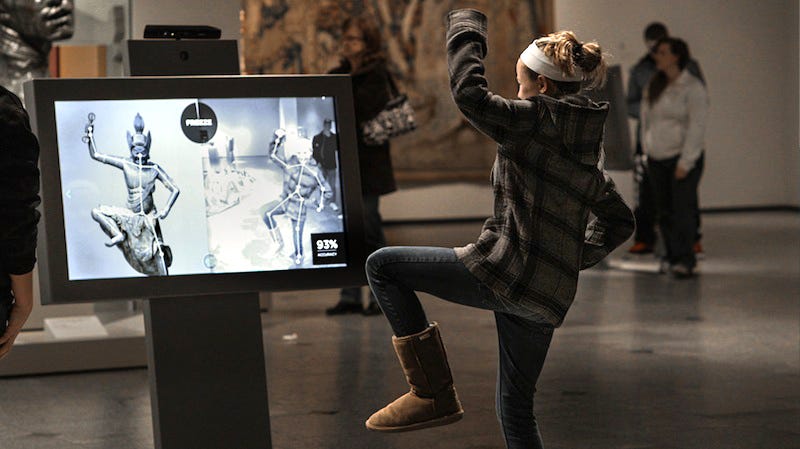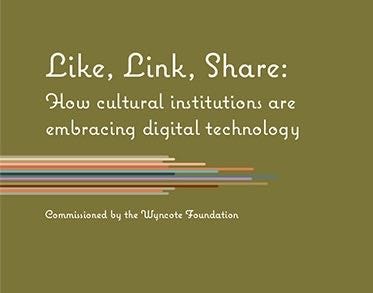 Photo
courtesy Cleveland Museum of Art
Photo
courtesy Cleveland Museum of ArtBy Sarah Lutman of 8 Bridges Workshop and Koven Smith

It’s been just about five years since Like, Link, Share: How cultural institutions are embracing digital technology, was published by the Philadelphia-based Wyncote Foundation. That study, authored by Sarah and Jessica Fiala as independent consultants, was an inquiry into ways that legacy cultural institutions were using digital technologies to further their missions, and to see what could be learned from the innovators doing the work.
A major benefit of Like, Link, Share was the number of conversations generated and relationships formed, not only between researchers and organizations but among the organizations studied. Koven, then at the Blanton Museum of Art in Austin, Texas, was one of the study’s interviewees who not only informed the study’s themes but, since leaving Blanton, became an 8 Bridges Workshop collaborator.
The premise of the report was that digital strategy is no longer optional but essential: the public expects to engage with culture digitally, to sample and share, to connect and participate.
Informed by thorough research into the practices of 40 legacy cultural institutions and site visits to eight organizations for deep conversations with staff, the report highlighted five key themes that are surprisingly resonant today. Innovators:
- shared an articulated digital strategy tied to their organizational strategy;
- were focused on building capabilities, not projects;
- had re-organized at the senior level to give digital practitioners a seat at the leadership table;
- were learning to adapt by orienting toward “audiences first”; and
- were experimenting with all manner of new business models to tie earned and contributed income to new digital capabilities and reach.
Digital adoption remains a challenge for many organizations in the space. Right now, 8 Bridges Workshop and Koven are collaborating on a research project looking at the range of digitally-delivered audience engagement tools available for services such as mobile ticketing, concierge options, and educational/enrichment offerings on behalf of a software developer that serves the cultural sector. From close range, they’re continuing to experience the differences in capabilities among cultural organizations and the gap between the experiences that commercial entertainment companies can provide compared to those available within even well-resourced cultural institutions.
Koven is also leading a project called the Museum Technology Charter, an online resource for museums seeking to engage with technology at an organizational level in responsible and sustainable ways. The Charter builds on many of the concepts identified in the Like, Link, Share report to provide an operational roadmap for technology implementation in a museum of any size or scope.
The Charter will describe current effective museum practices by looking at technology through multiple functional lenses. This is where it will depart from previous reports such as Like Link Share and the Horizon Report — Museum Edition. Where these reports looked at technology primarily through a strategic lens, the Charter will also examine technology implementation within the context of core museum values.
The structure of the Museum Technology Charter was defined during a convening held in Austin, Texas, in the spring of 2019, which brought together 24 thought leaders from across the museum and non-profit technology sector, The convening was funded by a grant from the Kress Foundation with the Museum Computer Network acting as fiscal sponsor.
The participants at the convening defined the scope of “museum technology” as consisting of six functional areas and nine lenses through which these functional areas can be viewed.
The Charter’s six functional areas are:
- digital engagement (which includes social media and other two-way communication technologies),
- online presence (which includes web and other broadcast technologies),
- evaluation and analytics,
- foundational systems (which includes critical infrastructure and security systems),
- business systems (which includes collections management, digital asset management, ticketing, constituent management, and similar systems), and
- content development (which encompasses media production and content authoring).
To each of these six functional areas, the Charter will apply the following lenses:
- privacy & security (with a particular focus on responsible handling of visitor/user data),
- organizational transparency,
- data stewardship (which includes conservation and longevity of data as well as licensing models),
- sustainability of systems,
- inclusion & equity (which includes understanding audiences as well as hiring practices),
- accessibility,
- decolonization (which involves assessing how data emphasizes dominant ways of knowing and organizing knowledge), and
- human-centricity (which involves designing systems to meet user needs, rather than just system needs).
The Charter is one indication of museums’ growing capacity for incorporating digital practice into their operations and embracing the potential of digital technology across all parts of organizational life, from presentation to operations. As these foundational elements of digital practice become more regularly embedded across museums and other legacy cultural institutions, the capacity for these institutions to foster public engagement with digital artmaking will grow.
This is good news for artists working in new and emerging forms of technology-infused practice, and something to look forward to as leading museums adopt the Charter and work to animate its multi-faceted components.
This piece is part of an issue of Immerse sponsored by the Knight Foundation in conjunction with Knight’s call for ideas to advance immersive arts experiences. Open for applications through August 12, the call offers recipients a share of $750,000 in funding, as well as optional technical support from Microsoft. Learn more.
Immerse is an initiative of the MIT Open DocLab and The Fledgling Fund, and it receives funding from Just Films | Ford Foundation and the MacArthur Foundation. IFP is our fiscal sponsor. Learn more here. We are committed to exploring and showcasing media projects that push the boundaries of media and tackle issues of social justice — and rely on friends like you to sustain ourselves and grow. Join us by making a gift today.